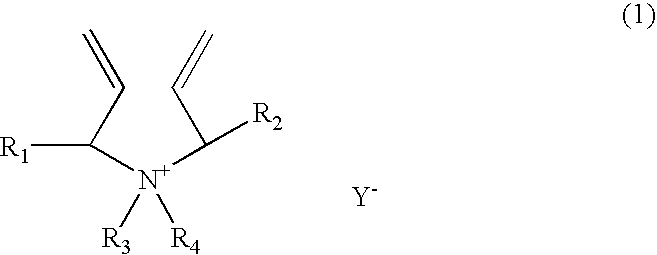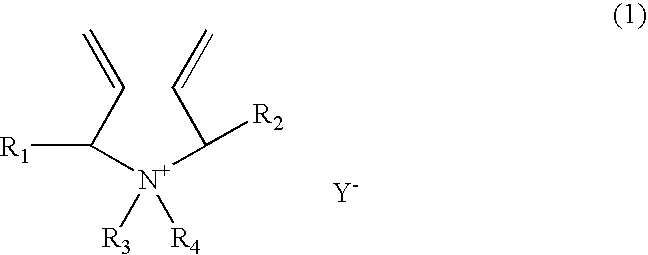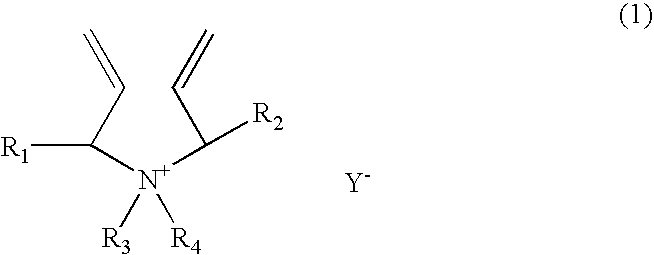Hydrophobically Modified Polymers as Laundry Additives
a technology of hydrophobic modification and polymer, which is applied in the direction of detergent compositions, detergent compounding agents, dyeing processes, etc., can solve the problems of color contamination and color fading of fabrics, and achieve the effects of reducing friction, improving fabric appearance, and reducing wear
- Summary
- Abstract
- Description
- Claims
- Application Information
AI Technical Summary
Benefits of technology
Problems solved by technology
Method used
Image
Examples
example 1
[0147] A 1-liter reactor equipped with a condenser, a thermometer, a nitrogen inlet, and an overhead agitator is charged with 453.8 g of 66% monomer DADMAC in water, 15.8 g of methyl methacrylate (MMA), 57.4.0 g of deionized water and 0.15 g of 20% Na4EDTA solution. The polymerization mixture is purged with nitrogen and heated with agitation to a temperature of 90° C. An aqueous solution containing 5.1 g of ammonium persulfate (APS) is slowly fed to the reactor over 190 minutes. The reaction temperature is allowed to increase to above 100° C. and then maintained at reflux temperature (100 to 100 to 110° C.) during the APS feed period. After the APS feed, the reaction temperature is lowered down to and held at 95° C. for about 30 minutes. Then an aqueous solution containing 5.6 g of sodium metabisulfite (MBS) is added over 30 minutes. The reactor content is held at 95° C. for another 30 minutes to complete the polymerization (above 99% conversion). The polymer solution is diluted wit...
example 2
[0148] A 1-liter reactor equipped with a condenser, a thermometer, a nitrogen inlet, and an overhead agitator is charged with 453.8 g of 66% monomer DADMAC in water, 15.8 g of ethoxylated nonylphenol acrylate (ENPA)), 57.4.0 g of deionized water and 0.15 g of 20% Na4EDTA solution. The polymerization mixture is purged with nitrogen and heated with agitation to a temperature of 900 C. An aqueous solution containing 5.1 g of ammonium persulfate (APS) is slowly fed to the reactor over 190 minutes. The reaction temperature is allowed to increase to above 100° C. and then maintained at reflux temperature (100 to 110° C.) during the APS feed period. After the APS feed, the reaction temperature is lowered down to and held at 95° C. for about 30 minutes. Then an aqueous solution containing 5.6 g of sodium metabisulfite (MBS) is added over 30 minutes. The reactor content is held at 95° C. for another 30 minutes to complete the polymerization (above 99% conversion). The polymer solution is dil...
example 3
[0149] This example demonstrates addition of hydrophobic monomer II by feeding. The polymerization procedure is the same as example 1 except that the amount of 15.8 9 methyl methacrylate is fed to the reactor over about 45 minutes when the APS initiator feed is started. The polymer solution is diluted with sufficient water to about 35% solids and cooled to room temperature. Total monomer conversion is measured to be above 99.5%. The final product has a Brookfield viscosity of 19,500 cps at 25° C. and 35% polymer solids. The final polymer product is dear as compared to the emulsion appearance of the Example 1 product
PUM
| Property | Measurement | Unit |
|---|---|---|
| Fraction | aaaaa | aaaaa |
| Fraction | aaaaa | aaaaa |
| Percent by mass | aaaaa | aaaaa |
Abstract
Description
Claims
Application Information
 Login to View More
Login to View More - R&D
- Intellectual Property
- Life Sciences
- Materials
- Tech Scout
- Unparalleled Data Quality
- Higher Quality Content
- 60% Fewer Hallucinations
Browse by: Latest US Patents, China's latest patents, Technical Efficacy Thesaurus, Application Domain, Technology Topic, Popular Technical Reports.
© 2025 PatSnap. All rights reserved.Legal|Privacy policy|Modern Slavery Act Transparency Statement|Sitemap|About US| Contact US: help@patsnap.com



